Business Research: Automation's Impact on Hyundai Motor Company
VerifiedAdded on 2021/05/30
|18
|4010
|120
Project
AI Summary
This research proposal investigates the impact of automation on job opportunities within Hyundai Motor Company. The study explores the increasing adoption of automated machines in Hyundai's manufacturing processes and its effects on the workforce. It aims to determine the current rate of automation usage, identify the benefits and drawbacks of automation, and analyze factors influencing the shift from human labor to automated systems. The research also seeks to develop strategies for balancing automation with human workforce needs to sustain productivity and efficiency. The proposal outlines the research questions, methodology, and anticipated outcomes, emphasizing the importance of understanding the relationship between automation and employment in the automotive industry. It will utilize both qualitative and quantitative analysis to examine the impact of automation, focusing on the potential for job displacement and the need for strategies to retain and support the human workforce within Hyundai Motors.
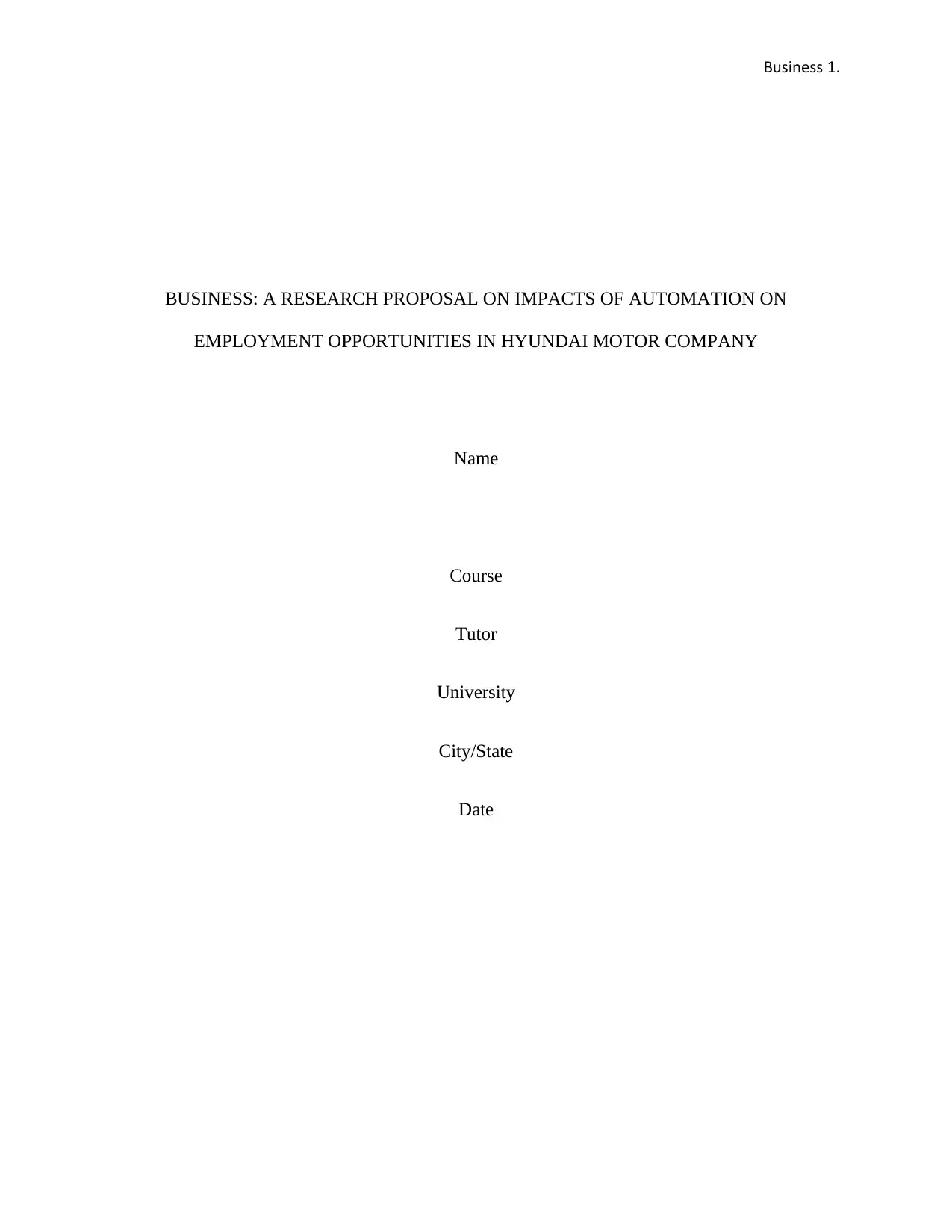
Business 1.
BUSINESS: A RESEARCH PROPOSAL ON IMPACTS OF AUTOMATION ON
EMPLOYMENT OPPORTUNITIES IN HYUNDAI MOTOR COMPANY
Name
Course
Tutor
University
City/State
Date
BUSINESS: A RESEARCH PROPOSAL ON IMPACTS OF AUTOMATION ON
EMPLOYMENT OPPORTUNITIES IN HYUNDAI MOTOR COMPANY
Name
Course
Tutor
University
City/State
Date
Paraphrase This Document
Need a fresh take? Get an instant paraphrase of this document with our AI Paraphraser
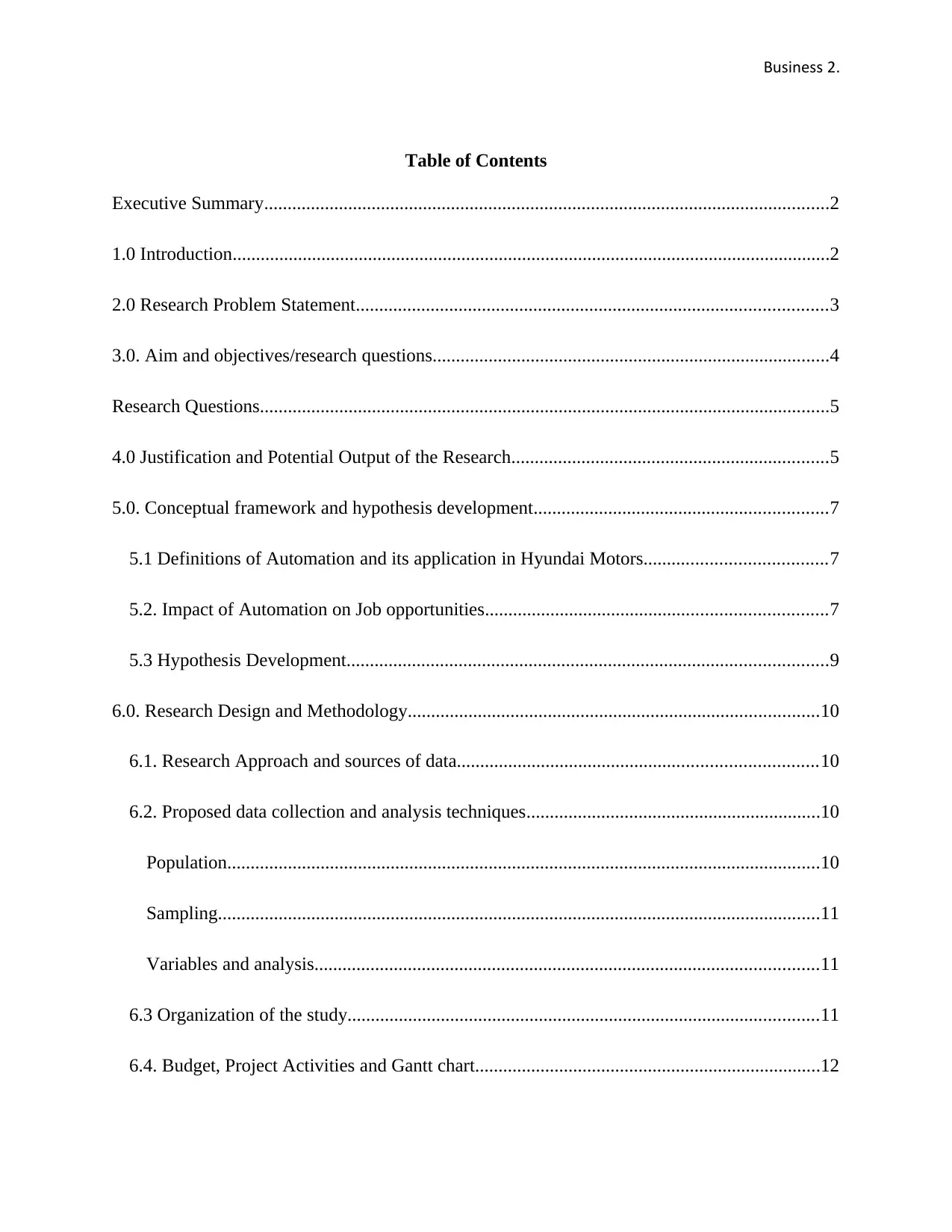
Business 2.
Table of Contents
Executive Summary.........................................................................................................................2
1.0 Introduction................................................................................................................................2
2.0 Research Problem Statement.....................................................................................................3
3.0. Aim and objectives/research questions.....................................................................................4
Research Questions..........................................................................................................................5
4.0 Justification and Potential Output of the Research....................................................................5
5.0. Conceptual framework and hypothesis development...............................................................7
5.1 Definitions of Automation and its application in Hyundai Motors.......................................7
5.2. Impact of Automation on Job opportunities.........................................................................7
5.3 Hypothesis Development.......................................................................................................9
6.0. Research Design and Methodology........................................................................................10
6.1. Research Approach and sources of data.............................................................................10
6.2. Proposed data collection and analysis techniques...............................................................10
Population...............................................................................................................................10
Sampling.................................................................................................................................11
Variables and analysis............................................................................................................11
6.3 Organization of the study.....................................................................................................11
6.4. Budget, Project Activities and Gantt chart..........................................................................12
Table of Contents
Executive Summary.........................................................................................................................2
1.0 Introduction................................................................................................................................2
2.0 Research Problem Statement.....................................................................................................3
3.0. Aim and objectives/research questions.....................................................................................4
Research Questions..........................................................................................................................5
4.0 Justification and Potential Output of the Research....................................................................5
5.0. Conceptual framework and hypothesis development...............................................................7
5.1 Definitions of Automation and its application in Hyundai Motors.......................................7
5.2. Impact of Automation on Job opportunities.........................................................................7
5.3 Hypothesis Development.......................................................................................................9
6.0. Research Design and Methodology........................................................................................10
6.1. Research Approach and sources of data.............................................................................10
6.2. Proposed data collection and analysis techniques...............................................................10
Population...............................................................................................................................10
Sampling.................................................................................................................................11
Variables and analysis............................................................................................................11
6.3 Organization of the study.....................................................................................................11
6.4. Budget, Project Activities and Gantt chart..........................................................................12
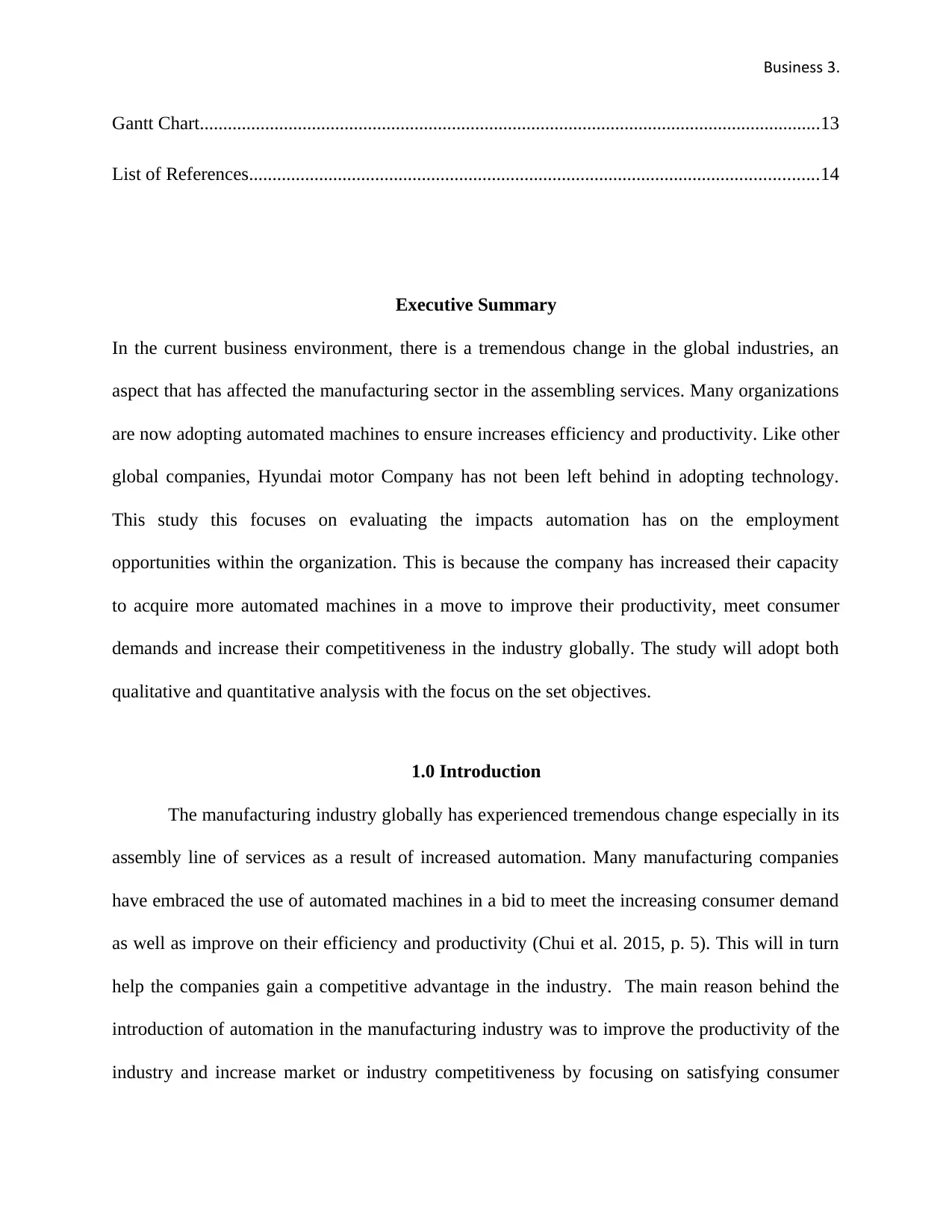
Business 3.
Gantt Chart.....................................................................................................................................13
List of References..........................................................................................................................14
Executive Summary
In the current business environment, there is a tremendous change in the global industries, an
aspect that has affected the manufacturing sector in the assembling services. Many organizations
are now adopting automated machines to ensure increases efficiency and productivity. Like other
global companies, Hyundai motor Company has not been left behind in adopting technology.
This study this focuses on evaluating the impacts automation has on the employment
opportunities within the organization. This is because the company has increased their capacity
to acquire more automated machines in a move to improve their productivity, meet consumer
demands and increase their competitiveness in the industry globally. The study will adopt both
qualitative and quantitative analysis with the focus on the set objectives.
1.0 Introduction
The manufacturing industry globally has experienced tremendous change especially in its
assembly line of services as a result of increased automation. Many manufacturing companies
have embraced the use of automated machines in a bid to meet the increasing consumer demand
as well as improve on their efficiency and productivity (Chui et al. 2015, p. 5). This will in turn
help the companies gain a competitive advantage in the industry. The main reason behind the
introduction of automation in the manufacturing industry was to improve the productivity of the
industry and increase market or industry competitiveness by focusing on satisfying consumer
Gantt Chart.....................................................................................................................................13
List of References..........................................................................................................................14
Executive Summary
In the current business environment, there is a tremendous change in the global industries, an
aspect that has affected the manufacturing sector in the assembling services. Many organizations
are now adopting automated machines to ensure increases efficiency and productivity. Like other
global companies, Hyundai motor Company has not been left behind in adopting technology.
This study this focuses on evaluating the impacts automation has on the employment
opportunities within the organization. This is because the company has increased their capacity
to acquire more automated machines in a move to improve their productivity, meet consumer
demands and increase their competitiveness in the industry globally. The study will adopt both
qualitative and quantitative analysis with the focus on the set objectives.
1.0 Introduction
The manufacturing industry globally has experienced tremendous change especially in its
assembly line of services as a result of increased automation. Many manufacturing companies
have embraced the use of automated machines in a bid to meet the increasing consumer demand
as well as improve on their efficiency and productivity (Chui et al. 2015, p. 5). This will in turn
help the companies gain a competitive advantage in the industry. The main reason behind the
introduction of automation in the manufacturing industry was to improve the productivity of the
industry and increase market or industry competitiveness by focusing on satisfying consumer
⊘ This is a preview!⊘
Do you want full access?
Subscribe today to unlock all pages.

Trusted by 1+ million students worldwide
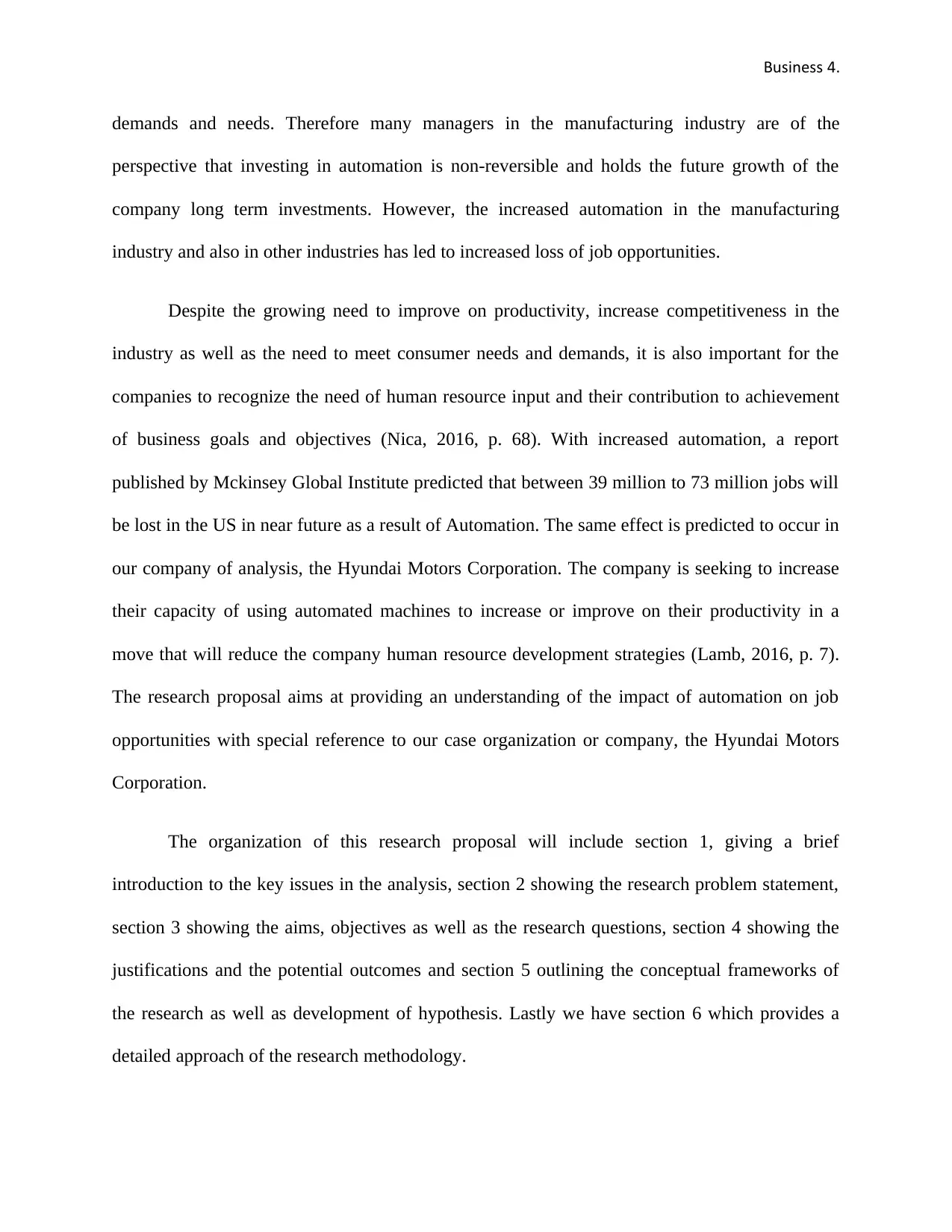
Business 4.
demands and needs. Therefore many managers in the manufacturing industry are of the
perspective that investing in automation is non-reversible and holds the future growth of the
company long term investments. However, the increased automation in the manufacturing
industry and also in other industries has led to increased loss of job opportunities.
Despite the growing need to improve on productivity, increase competitiveness in the
industry as well as the need to meet consumer needs and demands, it is also important for the
companies to recognize the need of human resource input and their contribution to achievement
of business goals and objectives (Nica, 2016, p. 68). With increased automation, a report
published by Mckinsey Global Institute predicted that between 39 million to 73 million jobs will
be lost in the US in near future as a result of Automation. The same effect is predicted to occur in
our company of analysis, the Hyundai Motors Corporation. The company is seeking to increase
their capacity of using automated machines to increase or improve on their productivity in a
move that will reduce the company human resource development strategies (Lamb, 2016, p. 7).
The research proposal aims at providing an understanding of the impact of automation on job
opportunities with special reference to our case organization or company, the Hyundai Motors
Corporation.
The organization of this research proposal will include section 1, giving a brief
introduction to the key issues in the analysis, section 2 showing the research problem statement,
section 3 showing the aims, objectives as well as the research questions, section 4 showing the
justifications and the potential outcomes and section 5 outlining the conceptual frameworks of
the research as well as development of hypothesis. Lastly we have section 6 which provides a
detailed approach of the research methodology.
demands and needs. Therefore many managers in the manufacturing industry are of the
perspective that investing in automation is non-reversible and holds the future growth of the
company long term investments. However, the increased automation in the manufacturing
industry and also in other industries has led to increased loss of job opportunities.
Despite the growing need to improve on productivity, increase competitiveness in the
industry as well as the need to meet consumer needs and demands, it is also important for the
companies to recognize the need of human resource input and their contribution to achievement
of business goals and objectives (Nica, 2016, p. 68). With increased automation, a report
published by Mckinsey Global Institute predicted that between 39 million to 73 million jobs will
be lost in the US in near future as a result of Automation. The same effect is predicted to occur in
our company of analysis, the Hyundai Motors Corporation. The company is seeking to increase
their capacity of using automated machines to increase or improve on their productivity in a
move that will reduce the company human resource development strategies (Lamb, 2016, p. 7).
The research proposal aims at providing an understanding of the impact of automation on job
opportunities with special reference to our case organization or company, the Hyundai Motors
Corporation.
The organization of this research proposal will include section 1, giving a brief
introduction to the key issues in the analysis, section 2 showing the research problem statement,
section 3 showing the aims, objectives as well as the research questions, section 4 showing the
justifications and the potential outcomes and section 5 outlining the conceptual frameworks of
the research as well as development of hypothesis. Lastly we have section 6 which provides a
detailed approach of the research methodology.
Paraphrase This Document
Need a fresh take? Get an instant paraphrase of this document with our AI Paraphraser
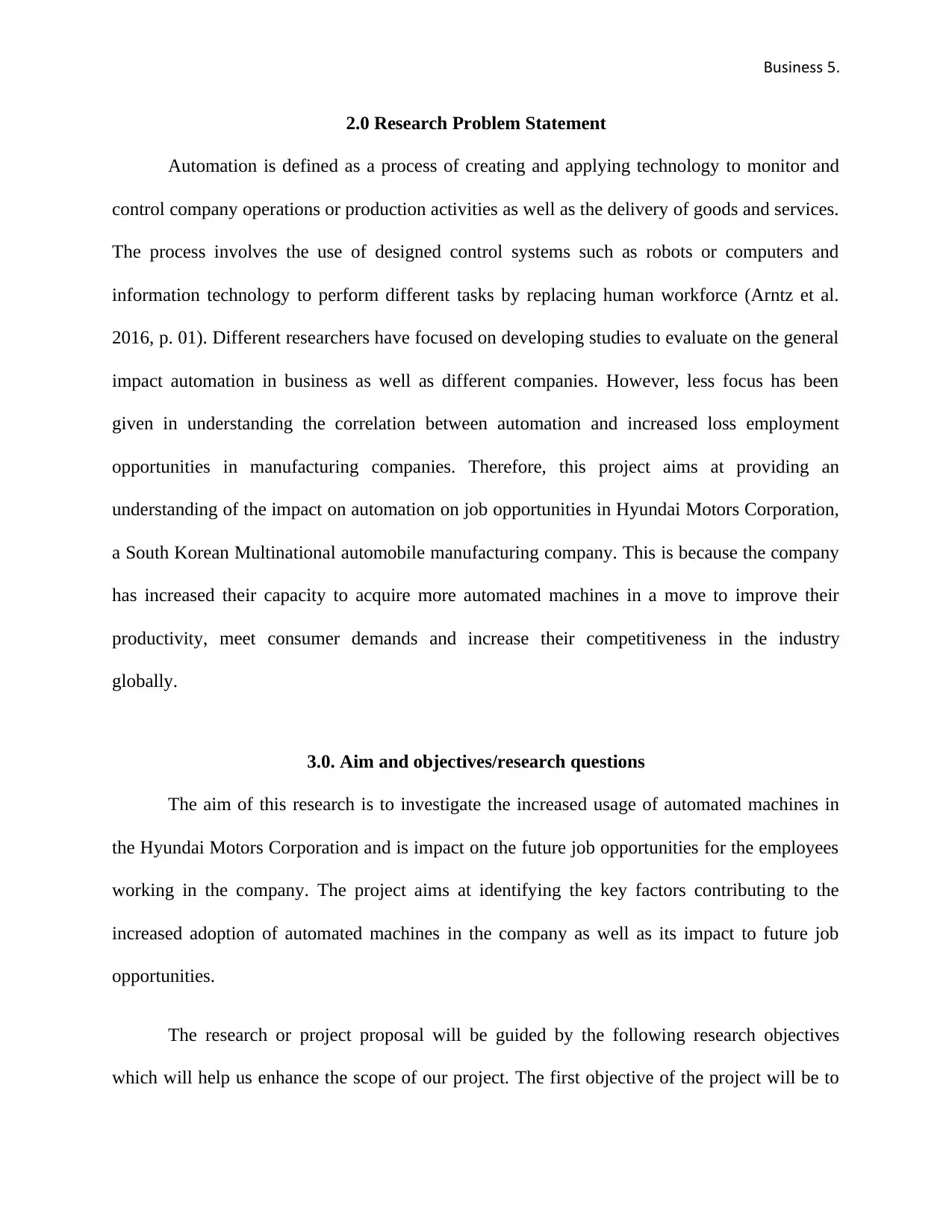
Business 5.
2.0 Research Problem Statement
Automation is defined as a process of creating and applying technology to monitor and
control company operations or production activities as well as the delivery of goods and services.
The process involves the use of designed control systems such as robots or computers and
information technology to perform different tasks by replacing human workforce (Arntz et al.
2016, p. 01). Different researchers have focused on developing studies to evaluate on the general
impact automation in business as well as different companies. However, less focus has been
given in understanding the correlation between automation and increased loss employment
opportunities in manufacturing companies. Therefore, this project aims at providing an
understanding of the impact on automation on job opportunities in Hyundai Motors Corporation,
a South Korean Multinational automobile manufacturing company. This is because the company
has increased their capacity to acquire more automated machines in a move to improve their
productivity, meet consumer demands and increase their competitiveness in the industry
globally.
3.0. Aim and objectives/research questions
The aim of this research is to investigate the increased usage of automated machines in
the Hyundai Motors Corporation and is impact on the future job opportunities for the employees
working in the company. The project aims at identifying the key factors contributing to the
increased adoption of automated machines in the company as well as its impact to future job
opportunities.
The research or project proposal will be guided by the following research objectives
which will help us enhance the scope of our project. The first objective of the project will be to
2.0 Research Problem Statement
Automation is defined as a process of creating and applying technology to monitor and
control company operations or production activities as well as the delivery of goods and services.
The process involves the use of designed control systems such as robots or computers and
information technology to perform different tasks by replacing human workforce (Arntz et al.
2016, p. 01). Different researchers have focused on developing studies to evaluate on the general
impact automation in business as well as different companies. However, less focus has been
given in understanding the correlation between automation and increased loss employment
opportunities in manufacturing companies. Therefore, this project aims at providing an
understanding of the impact on automation on job opportunities in Hyundai Motors Corporation,
a South Korean Multinational automobile manufacturing company. This is because the company
has increased their capacity to acquire more automated machines in a move to improve their
productivity, meet consumer demands and increase their competitiveness in the industry
globally.
3.0. Aim and objectives/research questions
The aim of this research is to investigate the increased usage of automated machines in
the Hyundai Motors Corporation and is impact on the future job opportunities for the employees
working in the company. The project aims at identifying the key factors contributing to the
increased adoption of automated machines in the company as well as its impact to future job
opportunities.
The research or project proposal will be guided by the following research objectives
which will help us enhance the scope of our project. The first objective of the project will be to
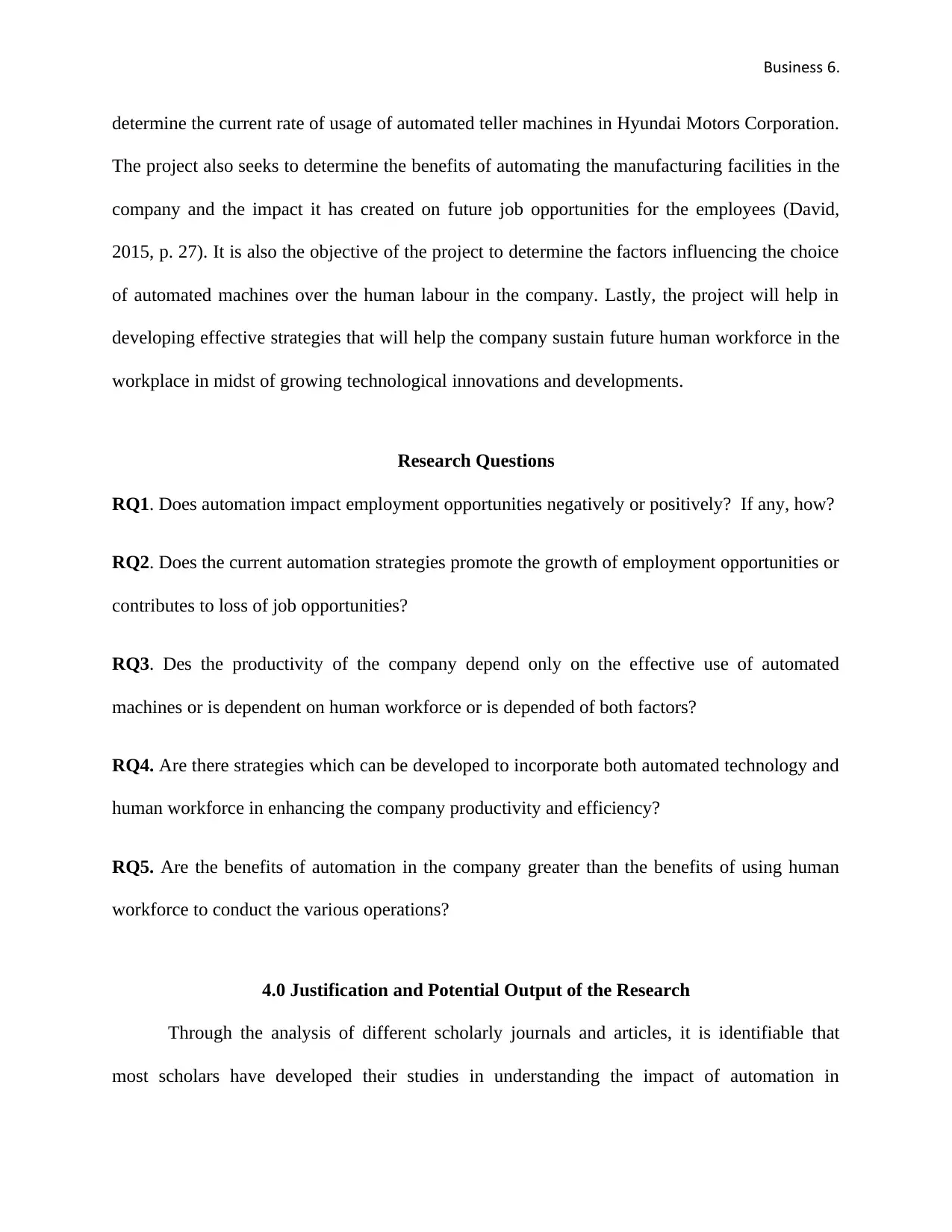
Business 6.
determine the current rate of usage of automated teller machines in Hyundai Motors Corporation.
The project also seeks to determine the benefits of automating the manufacturing facilities in the
company and the impact it has created on future job opportunities for the employees (David,
2015, p. 27). It is also the objective of the project to determine the factors influencing the choice
of automated machines over the human labour in the company. Lastly, the project will help in
developing effective strategies that will help the company sustain future human workforce in the
workplace in midst of growing technological innovations and developments.
Research Questions
RQ1. Does automation impact employment opportunities negatively or positively? If any, how?
RQ2. Does the current automation strategies promote the growth of employment opportunities or
contributes to loss of job opportunities?
RQ3. Des the productivity of the company depend only on the effective use of automated
machines or is dependent on human workforce or is depended of both factors?
RQ4. Are there strategies which can be developed to incorporate both automated technology and
human workforce in enhancing the company productivity and efficiency?
RQ5. Are the benefits of automation in the company greater than the benefits of using human
workforce to conduct the various operations?
4.0 Justification and Potential Output of the Research
Through the analysis of different scholarly journals and articles, it is identifiable that
most scholars have developed their studies in understanding the impact of automation in
determine the current rate of usage of automated teller machines in Hyundai Motors Corporation.
The project also seeks to determine the benefits of automating the manufacturing facilities in the
company and the impact it has created on future job opportunities for the employees (David,
2015, p. 27). It is also the objective of the project to determine the factors influencing the choice
of automated machines over the human labour in the company. Lastly, the project will help in
developing effective strategies that will help the company sustain future human workforce in the
workplace in midst of growing technological innovations and developments.
Research Questions
RQ1. Does automation impact employment opportunities negatively or positively? If any, how?
RQ2. Does the current automation strategies promote the growth of employment opportunities or
contributes to loss of job opportunities?
RQ3. Des the productivity of the company depend only on the effective use of automated
machines or is dependent on human workforce or is depended of both factors?
RQ4. Are there strategies which can be developed to incorporate both automated technology and
human workforce in enhancing the company productivity and efficiency?
RQ5. Are the benefits of automation in the company greater than the benefits of using human
workforce to conduct the various operations?
4.0 Justification and Potential Output of the Research
Through the analysis of different scholarly journals and articles, it is identifiable that
most scholars have developed their studies in understanding the impact of automation in
⊘ This is a preview!⊘
Do you want full access?
Subscribe today to unlock all pages.

Trusted by 1+ million students worldwide
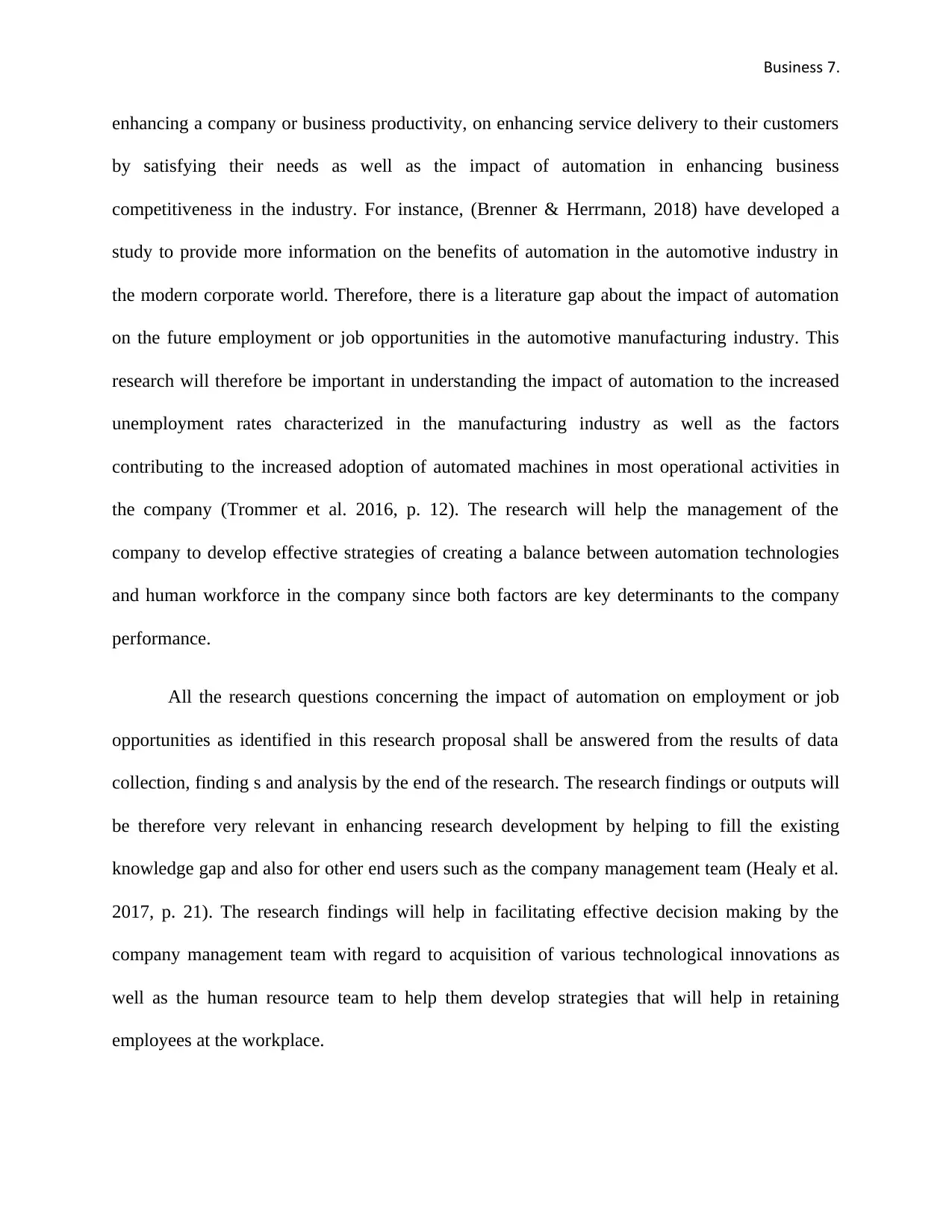
Business 7.
enhancing a company or business productivity, on enhancing service delivery to their customers
by satisfying their needs as well as the impact of automation in enhancing business
competitiveness in the industry. For instance, (Brenner & Herrmann, 2018) have developed a
study to provide more information on the benefits of automation in the automotive industry in
the modern corporate world. Therefore, there is a literature gap about the impact of automation
on the future employment or job opportunities in the automotive manufacturing industry. This
research will therefore be important in understanding the impact of automation to the increased
unemployment rates characterized in the manufacturing industry as well as the factors
contributing to the increased adoption of automated machines in most operational activities in
the company (Trommer et al. 2016, p. 12). The research will help the management of the
company to develop effective strategies of creating a balance between automation technologies
and human workforce in the company since both factors are key determinants to the company
performance.
All the research questions concerning the impact of automation on employment or job
opportunities as identified in this research proposal shall be answered from the results of data
collection, finding s and analysis by the end of the research. The research findings or outputs will
be therefore very relevant in enhancing research development by helping to fill the existing
knowledge gap and also for other end users such as the company management team (Healy et al.
2017, p. 21). The research findings will help in facilitating effective decision making by the
company management team with regard to acquisition of various technological innovations as
well as the human resource team to help them develop strategies that will help in retaining
employees at the workplace.
enhancing a company or business productivity, on enhancing service delivery to their customers
by satisfying their needs as well as the impact of automation in enhancing business
competitiveness in the industry. For instance, (Brenner & Herrmann, 2018) have developed a
study to provide more information on the benefits of automation in the automotive industry in
the modern corporate world. Therefore, there is a literature gap about the impact of automation
on the future employment or job opportunities in the automotive manufacturing industry. This
research will therefore be important in understanding the impact of automation to the increased
unemployment rates characterized in the manufacturing industry as well as the factors
contributing to the increased adoption of automated machines in most operational activities in
the company (Trommer et al. 2016, p. 12). The research will help the management of the
company to develop effective strategies of creating a balance between automation technologies
and human workforce in the company since both factors are key determinants to the company
performance.
All the research questions concerning the impact of automation on employment or job
opportunities as identified in this research proposal shall be answered from the results of data
collection, finding s and analysis by the end of the research. The research findings or outputs will
be therefore very relevant in enhancing research development by helping to fill the existing
knowledge gap and also for other end users such as the company management team (Healy et al.
2017, p. 21). The research findings will help in facilitating effective decision making by the
company management team with regard to acquisition of various technological innovations as
well as the human resource team to help them develop strategies that will help in retaining
employees at the workplace.
Paraphrase This Document
Need a fresh take? Get an instant paraphrase of this document with our AI Paraphraser
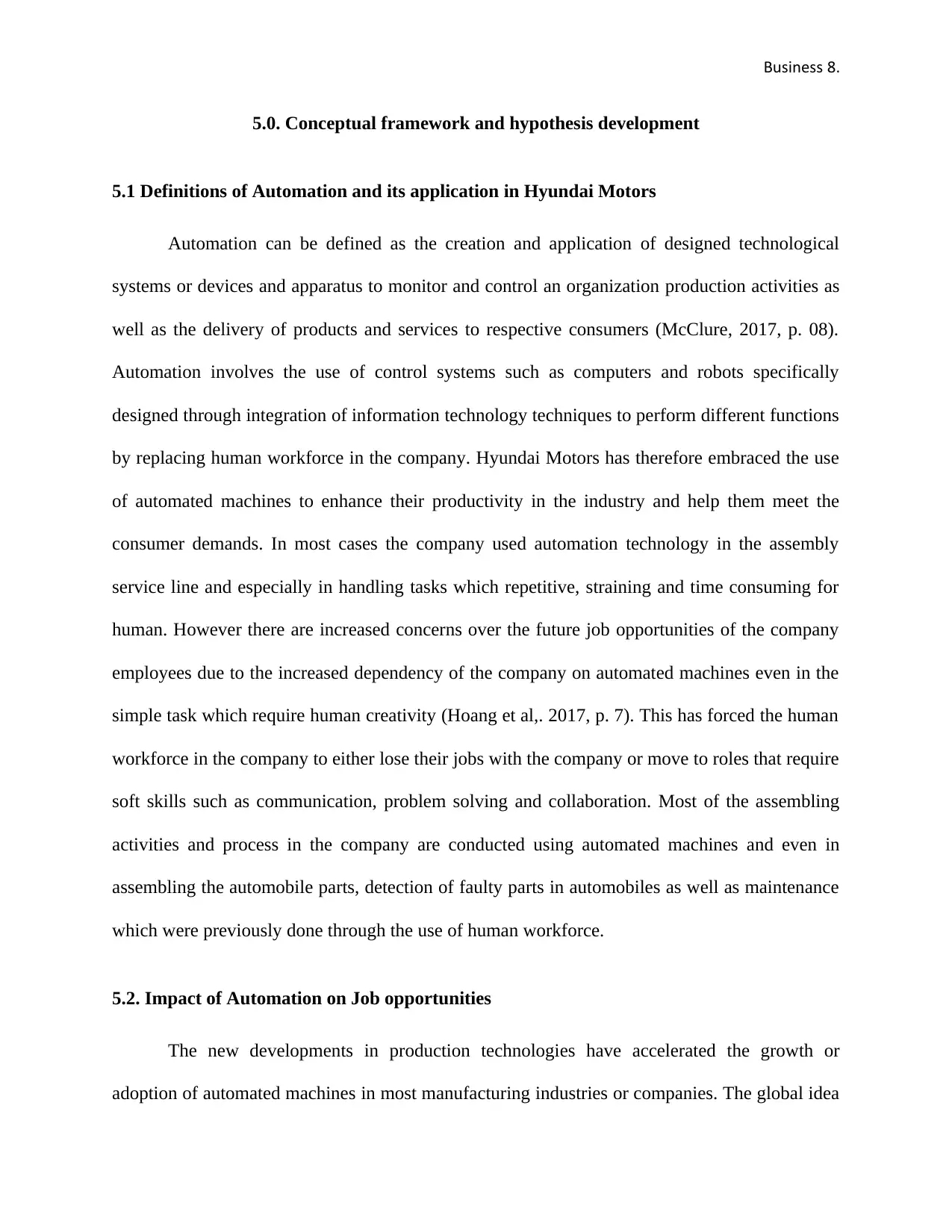
Business 8.
5.0. Conceptual framework and hypothesis development
5.1 Definitions of Automation and its application in Hyundai Motors
Automation can be defined as the creation and application of designed technological
systems or devices and apparatus to monitor and control an organization production activities as
well as the delivery of products and services to respective consumers (McClure, 2017, p. 08).
Automation involves the use of control systems such as computers and robots specifically
designed through integration of information technology techniques to perform different functions
by replacing human workforce in the company. Hyundai Motors has therefore embraced the use
of automated machines to enhance their productivity in the industry and help them meet the
consumer demands. In most cases the company used automation technology in the assembly
service line and especially in handling tasks which repetitive, straining and time consuming for
human. However there are increased concerns over the future job opportunities of the company
employees due to the increased dependency of the company on automated machines even in the
simple task which require human creativity (Hoang et al,. 2017, p. 7). This has forced the human
workforce in the company to either lose their jobs with the company or move to roles that require
soft skills such as communication, problem solving and collaboration. Most of the assembling
activities and process in the company are conducted using automated machines and even in
assembling the automobile parts, detection of faulty parts in automobiles as well as maintenance
which were previously done through the use of human workforce.
5.2. Impact of Automation on Job opportunities
The new developments in production technologies have accelerated the growth or
adoption of automated machines in most manufacturing industries or companies. The global idea
5.0. Conceptual framework and hypothesis development
5.1 Definitions of Automation and its application in Hyundai Motors
Automation can be defined as the creation and application of designed technological
systems or devices and apparatus to monitor and control an organization production activities as
well as the delivery of products and services to respective consumers (McClure, 2017, p. 08).
Automation involves the use of control systems such as computers and robots specifically
designed through integration of information technology techniques to perform different functions
by replacing human workforce in the company. Hyundai Motors has therefore embraced the use
of automated machines to enhance their productivity in the industry and help them meet the
consumer demands. In most cases the company used automation technology in the assembly
service line and especially in handling tasks which repetitive, straining and time consuming for
human. However there are increased concerns over the future job opportunities of the company
employees due to the increased dependency of the company on automated machines even in the
simple task which require human creativity (Hoang et al,. 2017, p. 7). This has forced the human
workforce in the company to either lose their jobs with the company or move to roles that require
soft skills such as communication, problem solving and collaboration. Most of the assembling
activities and process in the company are conducted using automated machines and even in
assembling the automobile parts, detection of faulty parts in automobiles as well as maintenance
which were previously done through the use of human workforce.
5.2. Impact of Automation on Job opportunities
The new developments in production technologies have accelerated the growth or
adoption of automated machines in most manufacturing industries or companies. The global idea
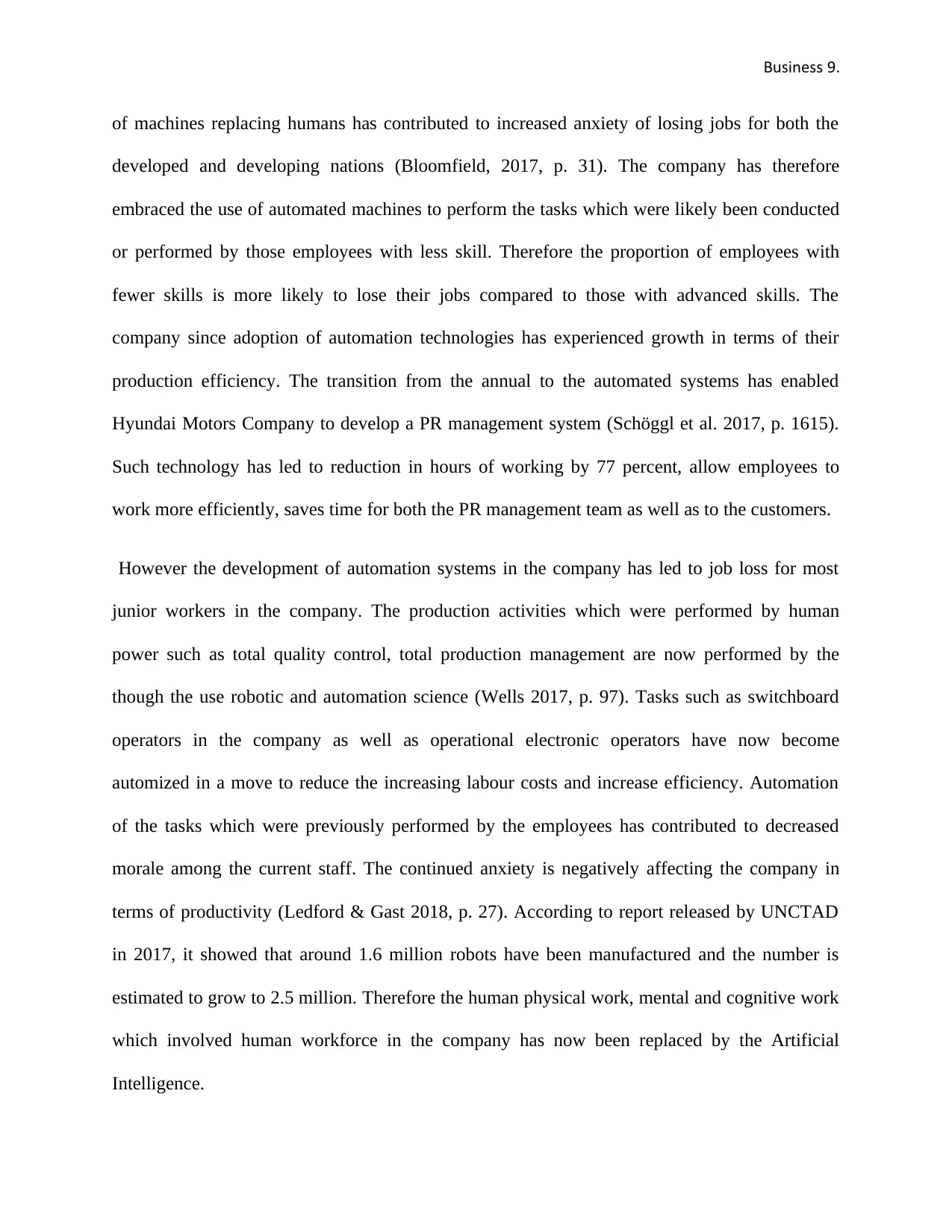
Business 9.
of machines replacing humans has contributed to increased anxiety of losing jobs for both the
developed and developing nations (Bloomfield, 2017, p. 31). The company has therefore
embraced the use of automated machines to perform the tasks which were likely been conducted
or performed by those employees with less skill. Therefore the proportion of employees with
fewer skills is more likely to lose their jobs compared to those with advanced skills. The
company since adoption of automation technologies has experienced growth in terms of their
production efficiency. The transition from the annual to the automated systems has enabled
Hyundai Motors Company to develop a PR management system (Schöggl et al. 2017, p. 1615).
Such technology has led to reduction in hours of working by 77 percent, allow employees to
work more efficiently, saves time for both the PR management team as well as to the customers.
However the development of automation systems in the company has led to job loss for most
junior workers in the company. The production activities which were performed by human
power such as total quality control, total production management are now performed by the
though the use robotic and automation science (Wells 2017, p. 97). Tasks such as switchboard
operators in the company as well as operational electronic operators have now become
automized in a move to reduce the increasing labour costs and increase efficiency. Automation
of the tasks which were previously performed by the employees has contributed to decreased
morale among the current staff. The continued anxiety is negatively affecting the company in
terms of productivity (Ledford & Gast 2018, p. 27). According to report released by UNCTAD
in 2017, it showed that around 1.6 million robots have been manufactured and the number is
estimated to grow to 2.5 million. Therefore the human physical work, mental and cognitive work
which involved human workforce in the company has now been replaced by the Artificial
Intelligence.
of machines replacing humans has contributed to increased anxiety of losing jobs for both the
developed and developing nations (Bloomfield, 2017, p. 31). The company has therefore
embraced the use of automated machines to perform the tasks which were likely been conducted
or performed by those employees with less skill. Therefore the proportion of employees with
fewer skills is more likely to lose their jobs compared to those with advanced skills. The
company since adoption of automation technologies has experienced growth in terms of their
production efficiency. The transition from the annual to the automated systems has enabled
Hyundai Motors Company to develop a PR management system (Schöggl et al. 2017, p. 1615).
Such technology has led to reduction in hours of working by 77 percent, allow employees to
work more efficiently, saves time for both the PR management team as well as to the customers.
However the development of automation systems in the company has led to job loss for most
junior workers in the company. The production activities which were performed by human
power such as total quality control, total production management are now performed by the
though the use robotic and automation science (Wells 2017, p. 97). Tasks such as switchboard
operators in the company as well as operational electronic operators have now become
automized in a move to reduce the increasing labour costs and increase efficiency. Automation
of the tasks which were previously performed by the employees has contributed to decreased
morale among the current staff. The continued anxiety is negatively affecting the company in
terms of productivity (Ledford & Gast 2018, p. 27). According to report released by UNCTAD
in 2017, it showed that around 1.6 million robots have been manufactured and the number is
estimated to grow to 2.5 million. Therefore the human physical work, mental and cognitive work
which involved human workforce in the company has now been replaced by the Artificial
Intelligence.
⊘ This is a preview!⊘
Do you want full access?
Subscribe today to unlock all pages.

Trusted by 1+ million students worldwide
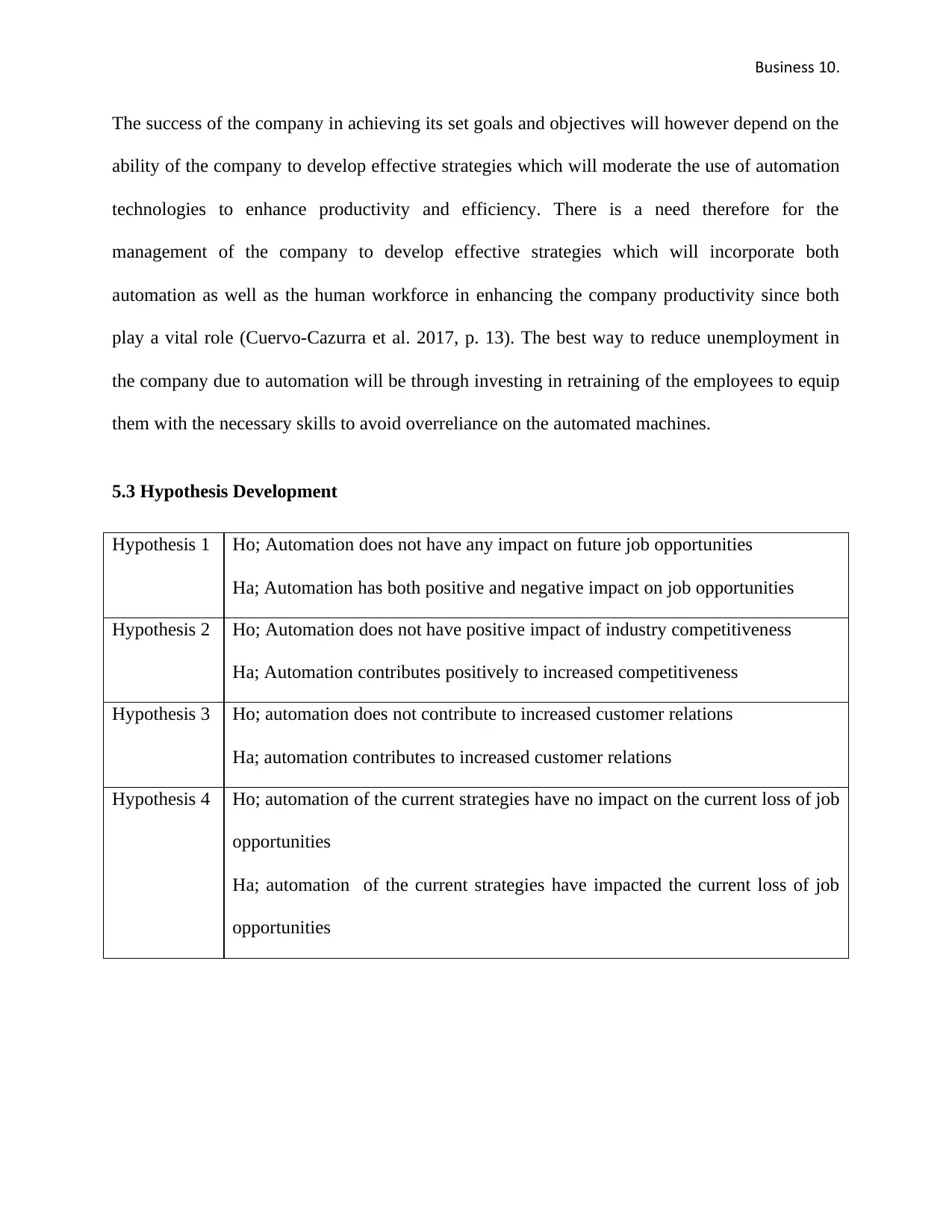
Business 10.
The success of the company in achieving its set goals and objectives will however depend on the
ability of the company to develop effective strategies which will moderate the use of automation
technologies to enhance productivity and efficiency. There is a need therefore for the
management of the company to develop effective strategies which will incorporate both
automation as well as the human workforce in enhancing the company productivity since both
play a vital role (Cuervo‐Cazurra et al. 2017, p. 13). The best way to reduce unemployment in
the company due to automation will be through investing in retraining of the employees to equip
them with the necessary skills to avoid overreliance on the automated machines.
5.3 Hypothesis Development
Hypothesis 1 Ho; Automation does not have any impact on future job opportunities
Ha; Automation has both positive and negative impact on job opportunities
Hypothesis 2 Ho; Automation does not have positive impact of industry competitiveness
Ha; Automation contributes positively to increased competitiveness
Hypothesis 3 Ho; automation does not contribute to increased customer relations
Ha; automation contributes to increased customer relations
Hypothesis 4 Ho; automation of the current strategies have no impact on the current loss of job
opportunities
Ha; automation of the current strategies have impacted the current loss of job
opportunities
The success of the company in achieving its set goals and objectives will however depend on the
ability of the company to develop effective strategies which will moderate the use of automation
technologies to enhance productivity and efficiency. There is a need therefore for the
management of the company to develop effective strategies which will incorporate both
automation as well as the human workforce in enhancing the company productivity since both
play a vital role (Cuervo‐Cazurra et al. 2017, p. 13). The best way to reduce unemployment in
the company due to automation will be through investing in retraining of the employees to equip
them with the necessary skills to avoid overreliance on the automated machines.
5.3 Hypothesis Development
Hypothesis 1 Ho; Automation does not have any impact on future job opportunities
Ha; Automation has both positive and negative impact on job opportunities
Hypothesis 2 Ho; Automation does not have positive impact of industry competitiveness
Ha; Automation contributes positively to increased competitiveness
Hypothesis 3 Ho; automation does not contribute to increased customer relations
Ha; automation contributes to increased customer relations
Hypothesis 4 Ho; automation of the current strategies have no impact on the current loss of job
opportunities
Ha; automation of the current strategies have impacted the current loss of job
opportunities
Paraphrase This Document
Need a fresh take? Get an instant paraphrase of this document with our AI Paraphraser
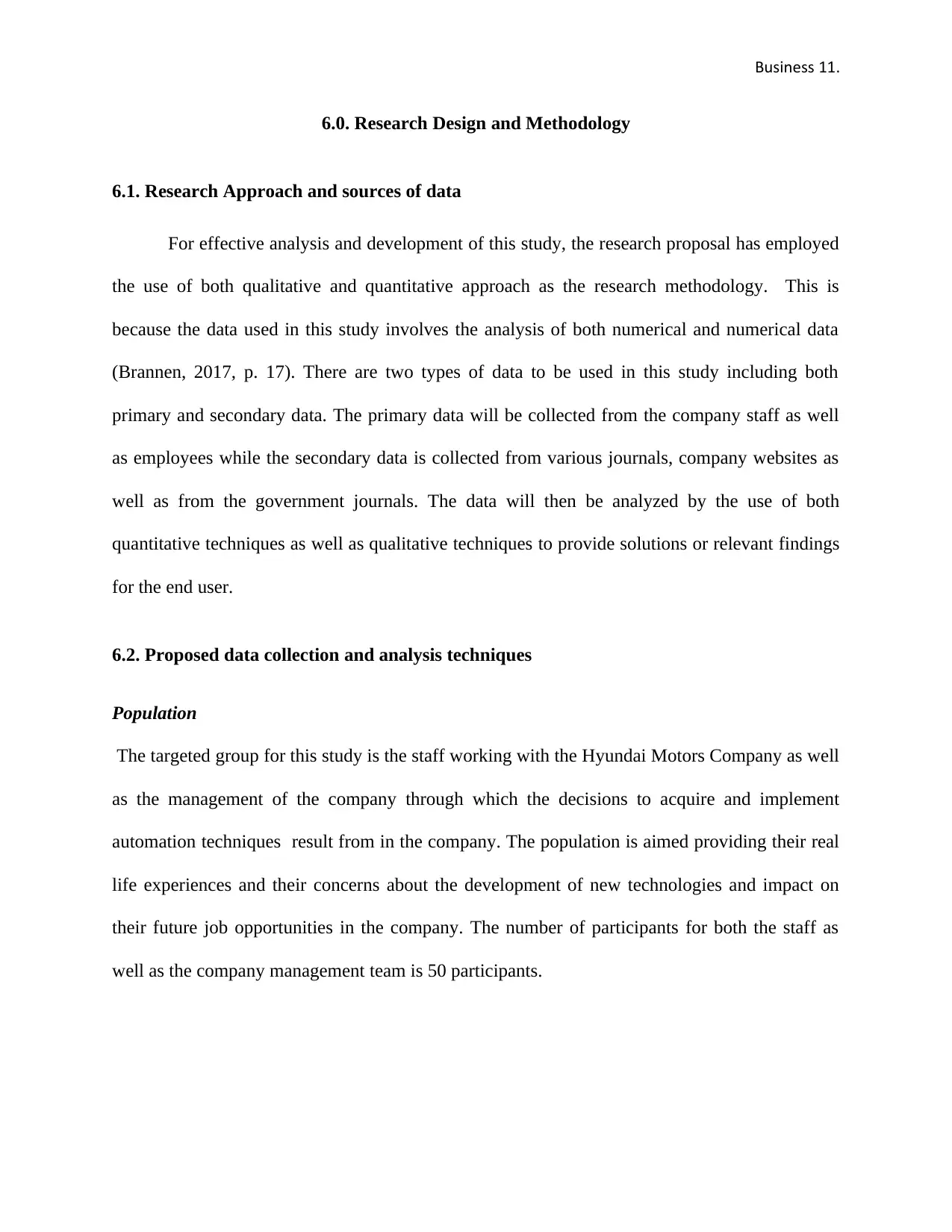
Business 11.
6.0. Research Design and Methodology
6.1. Research Approach and sources of data
For effective analysis and development of this study, the research proposal has employed
the use of both qualitative and quantitative approach as the research methodology. This is
because the data used in this study involves the analysis of both numerical and numerical data
(Brannen, 2017, p. 17). There are two types of data to be used in this study including both
primary and secondary data. The primary data will be collected from the company staff as well
as employees while the secondary data is collected from various journals, company websites as
well as from the government journals. The data will then be analyzed by the use of both
quantitative techniques as well as qualitative techniques to provide solutions or relevant findings
for the end user.
6.2. Proposed data collection and analysis techniques
Population
The targeted group for this study is the staff working with the Hyundai Motors Company as well
as the management of the company through which the decisions to acquire and implement
automation techniques result from in the company. The population is aimed providing their real
life experiences and their concerns about the development of new technologies and impact on
their future job opportunities in the company. The number of participants for both the staff as
well as the company management team is 50 participants.
6.0. Research Design and Methodology
6.1. Research Approach and sources of data
For effective analysis and development of this study, the research proposal has employed
the use of both qualitative and quantitative approach as the research methodology. This is
because the data used in this study involves the analysis of both numerical and numerical data
(Brannen, 2017, p. 17). There are two types of data to be used in this study including both
primary and secondary data. The primary data will be collected from the company staff as well
as employees while the secondary data is collected from various journals, company websites as
well as from the government journals. The data will then be analyzed by the use of both
quantitative techniques as well as qualitative techniques to provide solutions or relevant findings
for the end user.
6.2. Proposed data collection and analysis techniques
Population
The targeted group for this study is the staff working with the Hyundai Motors Company as well
as the management of the company through which the decisions to acquire and implement
automation techniques result from in the company. The population is aimed providing their real
life experiences and their concerns about the development of new technologies and impact on
their future job opportunities in the company. The number of participants for both the staff as
well as the company management team is 50 participants.
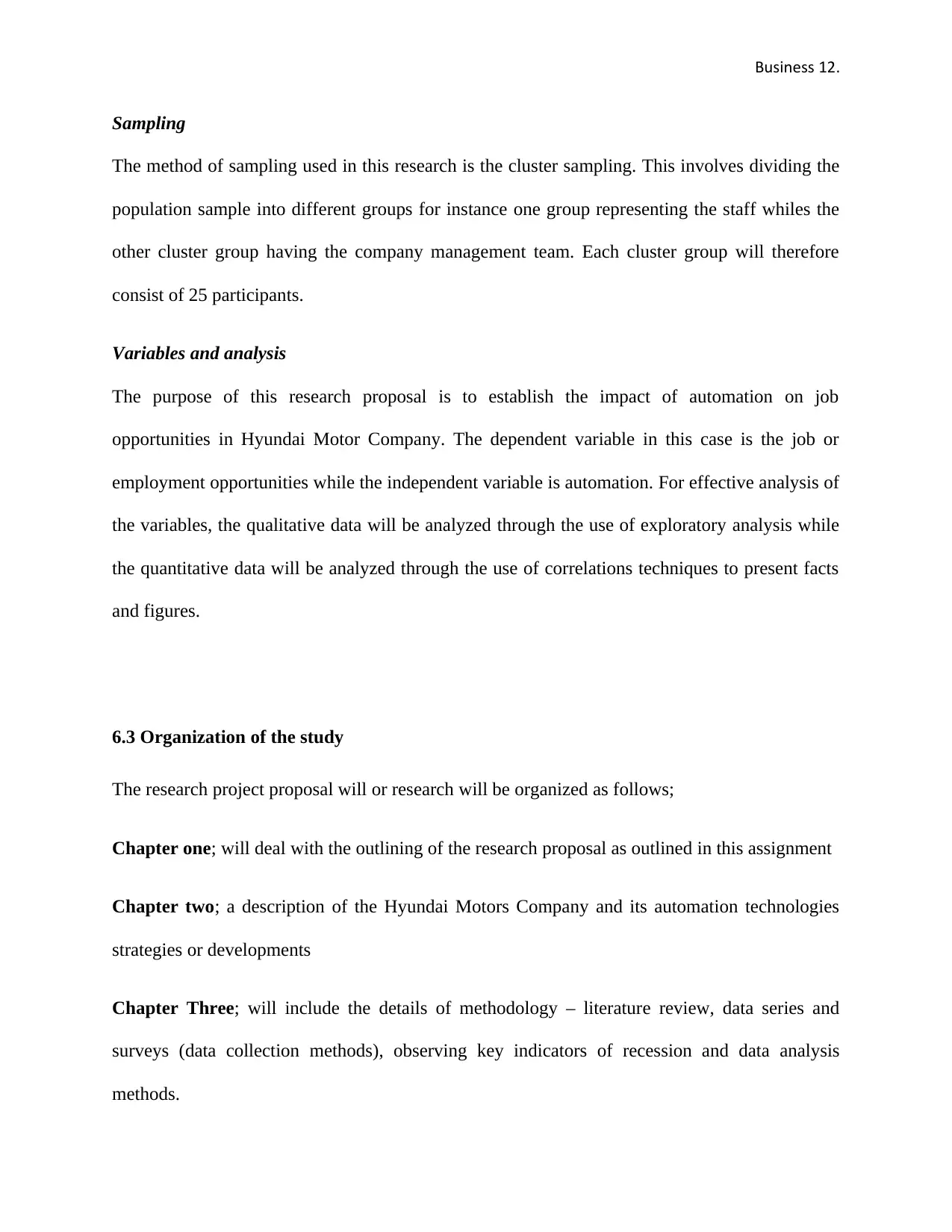
Business 12.
Sampling
The method of sampling used in this research is the cluster sampling. This involves dividing the
population sample into different groups for instance one group representing the staff whiles the
other cluster group having the company management team. Each cluster group will therefore
consist of 25 participants.
Variables and analysis
The purpose of this research proposal is to establish the impact of automation on job
opportunities in Hyundai Motor Company. The dependent variable in this case is the job or
employment opportunities while the independent variable is automation. For effective analysis of
the variables, the qualitative data will be analyzed through the use of exploratory analysis while
the quantitative data will be analyzed through the use of correlations techniques to present facts
and figures.
6.3 Organization of the study
The research project proposal will or research will be organized as follows;
Chapter one; will deal with the outlining of the research proposal as outlined in this assignment
Chapter two; a description of the Hyundai Motors Company and its automation technologies
strategies or developments
Chapter Three; will include the details of methodology – literature review, data series and
surveys (data collection methods), observing key indicators of recession and data analysis
methods.
Sampling
The method of sampling used in this research is the cluster sampling. This involves dividing the
population sample into different groups for instance one group representing the staff whiles the
other cluster group having the company management team. Each cluster group will therefore
consist of 25 participants.
Variables and analysis
The purpose of this research proposal is to establish the impact of automation on job
opportunities in Hyundai Motor Company. The dependent variable in this case is the job or
employment opportunities while the independent variable is automation. For effective analysis of
the variables, the qualitative data will be analyzed through the use of exploratory analysis while
the quantitative data will be analyzed through the use of correlations techniques to present facts
and figures.
6.3 Organization of the study
The research project proposal will or research will be organized as follows;
Chapter one; will deal with the outlining of the research proposal as outlined in this assignment
Chapter two; a description of the Hyundai Motors Company and its automation technologies
strategies or developments
Chapter Three; will include the details of methodology – literature review, data series and
surveys (data collection methods), observing key indicators of recession and data analysis
methods.
⊘ This is a preview!⊘
Do you want full access?
Subscribe today to unlock all pages.

Trusted by 1+ million students worldwide
1 out of 18
Related Documents
Your All-in-One AI-Powered Toolkit for Academic Success.
+13062052269
info@desklib.com
Available 24*7 on WhatsApp / Email
![[object Object]](/_next/static/media/star-bottom.7253800d.svg)
Unlock your academic potential
Copyright © 2020–2025 A2Z Services. All Rights Reserved. Developed and managed by ZUCOL.




